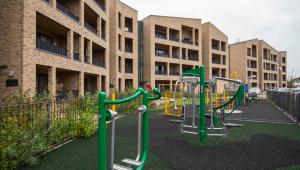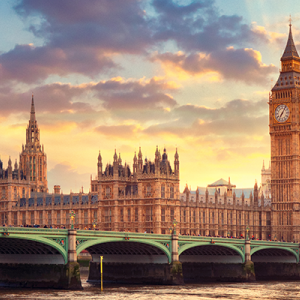02 June 2006
Social housing shot to the top of the political agenda after the BNP's shock success in the Barking & Dagenham election. So what are ministers doing to make more affordable housing available to all? Tash Shifrin delves behind the myth-making
Housing is not usually a headline-grabber, nor a topic to make ministers sweat. It occupies the quieter suburbs of the public service landscape, far from the flashlights and media frenzy that surround NHS finances or problems in children's social services. But in the wake of last month's local government elections, it shot suddenly to the top of the political agenda.
The trigger was shock at the election of 11 British National Party councillors in the outer east London borough of Barking and Dagenham – and the feeling that along with stirring up racism, the BNP had been able to exploit discontent over the lack of affordable rented housing in the area, scapegoating asylum seekers, black people and those from ethnic minorities.
The housing issue had been raised before the May 4 vote by Barking MP – and now trade and industry minister – Margaret Hodge, in comments widely criticised for talking up the BNP's chances ahead of the poll. She claimed that eight out of ten white people in the area were tempted to vote for the BNP, adding: 'They can't get a home for their children, they see black and ethnic minority communities moving in and they are angry.'
Barking and Dagenham council operates a choice-based lettings system, where people on the housing register can choose whether to take one of the properties on offer or wait for something better to come up (see below). It does not allocate properties by race, nor is there a breakdown by ethnicity of who has been housed. There is no evidence that white people are 'losing out' to black people or those from ethnic minorities.
A spokesman confirms that the council has housed asylum seekers – they now occupy a grand total of four properties out of the 20,000 for which the council can nominate tenants. Whatever is making it difficult for people in the borough to get a council flat, it is clearly not asylum seekers.
But behind the myth-making, there is one grain of truth: affordable housing really is in short supply. 'There are not enough properties to go round,' the spokesman says. 'The estimated shortfall is probably about 6,000 homes.'
In her pre-election remarks, Hodge criticised her own government's housing policy. 'There was nowhere for the local people to move to and we did not reinvest in social housing, nor did the Tories. Neither of us have done enough of that,' she said.
'It isn't that we have done nothing. But where we haven't done enough is affordable housing for families and the quality of life for families. Were we to blame for the change? No, it happened on the back of right to buy. But we could have built more affordable housing. We must do that. It isn't happening yet.'
Ministers were quick to promise action after the Barking and Dagenham election results – perhaps also mindful of the vote in the inner London borough of Tower Hamlets, where the anti-war Respect party took 12 seats after campaigning specifically on the housing shortage.
Newly appointed Communities and Local Government Secretary Ruth Kelly pledged that providing more affordable homes would be 'a personal priority', adding: 'The case for building more homes is clear. If we don't, then less than a third of today's ten-year-olds will be able to afford a home of their own in 20 years' time.'
A spokesman from the Department for Communities and Local Government gives the stark details: 'Because more households are being formed, and people are living longer, we simply don't have enough homes to meet demand. Between 1971 and 2001, the number of households grew by 5 million, or 30%. It is projected to increase by a further 5 million by 2026 – an annual increase of 209,000. The number of households in temporary accommodation reached an all-time high of 100,000 during 2004. In London, 7% of homes are overcrowded.'
The government has allocated £3.9bn to the Housing Corporation to fund the development of 84,000 affordable homes over the next two years, continuing a building programme based on four growth areas – the Thames Gateway, Milton Keynes/South Midlands, Ashford, Kent and the M11 Stansted/Cambridge corridor. There are smaller projects in other areas of urban decline, and funds for 6,000 new affordable homes in rural areas were announced after a warning report from the Affordable Rural Housing Commission.
But Kelly has acknowledged that the increase in housing is not enough to cope. 'There are currently more than 200,000 new households a year but house-building is not keeping pace, with only 160,000 new homes built last year,' she said. The government was 'committed to reforming the planning system to bring forward more brownfield land for development in high demand areas'.
Adam Sampson, director of housing charity Shelter, says the scale of unmet need is 'massive'. There are several types of people in need of housing they can afford, although some people fall into more than one group, he says. First, there are 'just shy of 100,000 households' in temporary accommodation, with their average length of stay 'increasing rapidly'.
The number of households in temporary accommodation has doubled since Labour came to power in 1997, Sampson notes.
Then there are another 250,000 to 500,000 people who 'on anybody's count are homeless', but do not meet the statutory definition of homelessness. They are not necessarily on the streets – Sampson credits the government with success in tackling rough sleeping – but moving between hostels, friends' floors, short periods in temporary accommodation and in some cases, prison. 'It's very difficult to quantify this,' Sampson says.
He adds: 'Further to that, hundreds of thousands of people are statutorily overcrowded – 30% of children in social housing in London are statutorily overcrowded. This is big. Add in homes that are unfit for human habitation – there's 1 million, of which roughly 90% are occupied. The final measure is the number of people on [council] waiting lists – 1.5 million.'
The picture of housing need is uneven across the country. The housing crisis is at its sharpest in London and the Southeast, while in some northern towns and cities, rows of terraces are empty and abandoned as people move away looking for jobs or a higher quality of life.
But Abigail Davies, policy officer at the Chartered Institute of Housing, says this picture can be 'misleading', with the ratio between earnings and local housing costs leaving many people struggling in other areas of the country too. 'In parts of the Northwest, the Southwest, bits of Yorkshire – the “golden triangle” of Leeds, Harrogate and York – there are massive affordability problems.'
Local Government Association policy officer Sandra Brown says varying local differences are the reason why councils should be given the resources and freedom to tackle local housing needs locally – whether they do this themselves or through housing associations. At present, income from the nationally pooled Housing Revenue Account is redistributed on a regional basis, losing the connection with local needs. 'Local authorities and local people are best placed to see what they need. [There should be] mechanisms that would allow local authorities to have the income to help finance local housing,' she says.
Brown points to an Audit Commission review of housing finance that suggested releasing high-performing authorities that could be self-financing from the national system.
Davies says increased investment by the government through the Housing Corporation is 'starting to come through as housing on the ground… but one issue is that it's focused on intermediate housing [shared ownership schemes] and home ownership'.
Of the government's 84,000 planned new homes, 49,000 will be for rent and 35,000 for 'low-cost home ownership'. Davies warns that 'the affordability issue is quite stark'. While welcoming the extra housing for full or part-ownership, she warns: 'We wouldn't want that increase to be at the expense of social rented housing. It should be additional, so the numbers [of social rented units] are retained. Intermediate housing, particularly in high-cost areas, is not affordable to people on low to medium incomes.'
The nub of the problem is that for those who cannot afford to buy or rent a home on the private property market, the supply of 'social rented' accommodation, traditionally provided by councils, has fallen dramatically. Since Margaret Thatcher introduced the right to buy policy, allowing council tenants to buy their homes, the stock of council houses has shrunk drastically.
In 1980, local authority housing accounted for 29% of all tenancies, with registered social landlords – housing associations – covering another 2%. By 2004, the proportion of council housing had plummeted to just 11%, with 8% run by RSLs.
The statistics reveal the shrinking of the social rented sector overall, but the shift from council housing to housing association-run homes has brought its own controversy – one that rumbles especially loudly on the Labour backbenches. The growth of the RSLs has come not only because the government channels new investment into them, but through council stock transfer.
The policy of encouraging tenants to vote for the transfer of their council estates to housing associations was begun by the Conservatives. Labour has refined the policy, in an effort to raise the money to meet a £19bn bill for a long backlog of repairs and renovation and meet its pledge to bring the housing stock up to a 'decent homes' standard by 2010. Housing associations have succeeded in levering in substantial extra funds, the government argues.
But the three-way choice now offered to tenants – development of their homes through the Private Finance Initiative, old-style stock transfer or handover to an arm's-length management organisation (Almo) – has been rejected in almost 100 local authorities, despite the fact that rejecting the Almo option means the forfeit of extra government funds.
Tenants, grouped together in the Defend Council Housing campaign, have demanded a 'fourth option' – the right to vote for councils to retain control over their homes, without forfeiting the extra cash. The call was backed by Labour's party conference last year.
The situation is delicate for the government – it is under pressure to act on housing, but if it continues to snub council housing in favour of the RSLs, any action risks opening up the divide in the parliamentary Labour Party. A DCLG spokesman is adamant that 'there is no fourth option', but Labour MP Austin Mitchell, chair of the Council Housing Group of MPs, suggests that there could be movement. He is set for a meeting to discuss the question with housing minister Yvette Cooper. 'We've met once and she's sympathetic and wants us to discuss it with officials,' he says.
The government will have to move if tenants continue to reject its policies, he believes. 'I think the government's run into an impasse. Progress towards privatisation is slowing down. Tenants are voting against it.'
Mitchell argues that if the government allowed local authorities to retain all their housing income, handed back the £0.5bn to £0.6bn taken by central government from right to buy receipts and let councils borrow under the 2004 Local Government Act, 'that, without further spending, would allow for not just repairs and refurbishment, but to begin building. We're not calling for a big handout from government, we're just asking them to stop taking money away from councils.'
Shelter's Sampson does want to see fresh money, though. He wants the government to increase its building programme by an extra 20,000 houses a year. 'The government does have to rediscover its responsibility for ensuring the poorest people in our society are housed,' he says.
'That does mean, when push comes to shove, the chancellor putting his hand in his pocket and providing the money to build houses in the way we used to in this country. The price for that is between £1bn and £1.25bn a year in additional funding. It's a big ask.'
In April, John Prescott, then heading the DCLG's predecessor, the Office of the Deputy Prime Minister, ordered a review of the government's national housing strategy. Kelly will now be the one to deliver. It is too soon to tell whether the review, which is set to report in July, will prompt much change in government housing policy. But after the May elections, Ruth Kelly will be keenly aware of the potential political price if she fails to deliver on her 'personal priority'.
Barking up the wrong tree
Around 166,000 people live in the London Borough of Barking and Dagenham, on the edge of Essex. It is a poor area — the 42nd poorest of 354 local authorities in England and Wales — and Barking High Street has three pawnbroker's shops, where the working poor queue to get credit on their personal belongings.
It should not be surprising that council housing is a big issue for people here, where 34.4% of households rent from the local authority — far higher than the London-wide figure of 17.1% or the national 13.2%. Another 2.6% of Barking households live in a housing association property.
Labour councillor Lee Waker, who kept his seat but saw a BNP councillor elected in his ward, says most people in the area are 'reasonable — they're not all racists'. But he says people do feel that 'if they've always lived in the borough', their needs should also be met.
'This is the lowest-paid borough in Greater London. For 80 years here, there's always been a culture that people go to the council and the council accommodates them. That system's always worked well, but it's got more difficult in the past ten years.'
The problem is due to the loss of housing stock under the right to buy scheme, he says. But some people have believed the 'Jackanory stories' about mythical council handouts of £50,000 going to people from ethnic minorities. He traces the area's growth through housing developments of the 1930s, the post-war years and the 1970s. Then 'it all ground to a halt', he says.
The council has around 20,000 properties now, after a 23% loss from right to buy. But a spokesman says the loss is slowing, with only 246 homes gone in the past year.
There are 7,865 people on the housing register, who can choose to take up a housing offer or wait longer for a better one. The 'desperate' ones are housed within weeks, he says, while others wait months. But there is an overall shortfall of 'probably about 6,000 homes', the council says.
The council has nomination rights to some housing association property, and 550 affordable properties were built through RSLs in the borough last year, under a mix of key worker, shared ownership and other schemes. Under the Thames Gateway development, 6,000 homes 'will be allocated to local people and will be affordable, either shared ownership or social rented', he adds.
PFjun2006




















